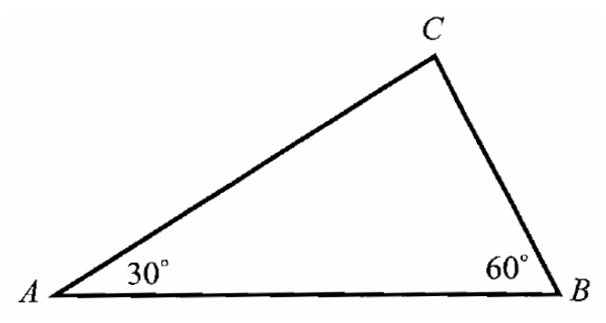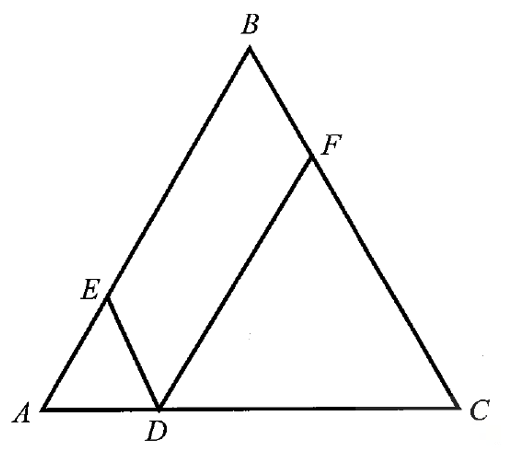WRITE INEQUALITIES FROM GRAPHS
Inequalities in One Variable from Graphs
In the graph of an inequality in one variable, if there is empty circle, we have to use < and > in the inequality.
In the graph of an inequality in one variable, if there is filled circle, we have to use ≤ and ≥ in the inequality.
More clearly,
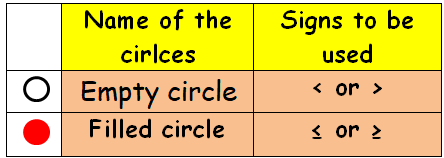
Example 1 :
Write the inequality for the graph given below.

Solution :
In the above graph, we find the filled circle. So we have to use the sign ≤ or ≥.
Now we have to look into the shaded portion. Since the shaded region is in left hand side from the filled circle, we have to use the sign "≤ ".
The inequality for the above graph is x ≤ 4.
Example 2 :
Write the inequality for the graph given below.

Solution :
In the above graph, we find the unfilled circle. So we have to use the sign < or >.
Now we have to look into the shaded portion. Since the shaded region is in right hand side from the unfilled circle, we have to use the sign "> ".
The inequality for the above graph is x > -6.
Example 3 :
Write the inequality for the graph given below.

Solution :
In the above graph, we find the unfilled circle. So we have to use the sign < or >.
Now we have to look into the shaded portion. Since the shaded region is in left hand side from the unfilled circle, we have to use the sign "<".
The inequality for the above graph is x < 1.
Example 4 :
Write the inequality for the graph given below.

Solution :
In the above graph, we find the unfilled circle. So we have to use the sign ≤ or ≥.
Now we have to look into the shaded portion. Since the shaded region is in right hand side from the unfilled circle, we have to use the sign "≥".
The inequality for the above graph is x ≥ 1.
Inequalities in Two Variables from Graph
To find linear inequalities in two variables from graph, first we have to find two information from the graph.
(i) Slope
(ii) y -intercept
By using the above two information we can easily get a linear linear equation in the form y = mx + b.
Here "m" stands for slope and "b" stands for y-intercept.
Now we have to notice whether the given line is solid line or dotted line.
- If the graph contains the dotted line, then we have to use one of the signs < or >.
- If the graph contains the solid line, then we have to use one of the signs ≤ or ≥.
Example 5 :
Write the inequality for the graph given below.
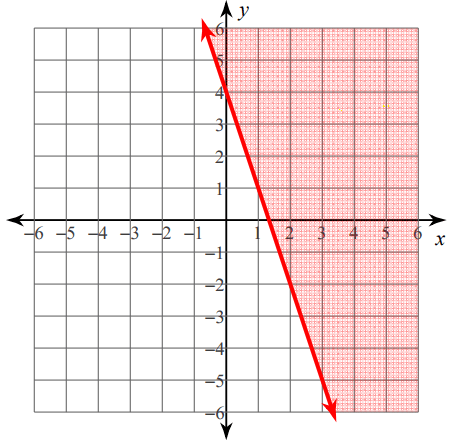
Solution :
From the above graph, first let us find the slope and y-intercept.
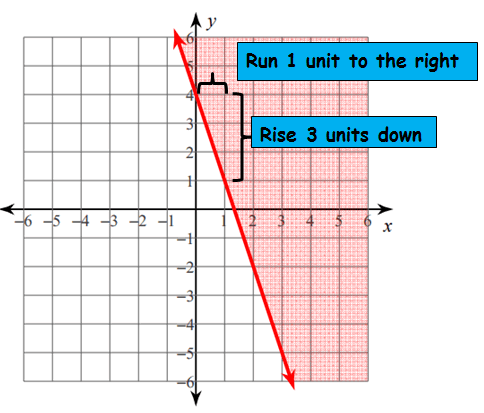
Rise = -3 and Run = 1
Slope = -3 / 1 = -3
y-intercept = 4
So, the equation of the given line is
y = -3x + 4
But we need to use inequality which satisfies the shaded region.
Since the graph contains solid line, we have to use one of the signs ≤ or ≥.
To fix the correct sign, let us take a point from the shaded region.
Take the point (2, 1) and apply it in the equation
y = -3x + 4
1 = -3(2) + 4
1 = -6 + 4
1 = - 2
Here 1 is greater than -2, so we have to choose the sign ≥ instead of equal sign in the equation y = -3x + 4.
Hence, the required inequality is
y ≥ -3x + 4
Example 6 :
Which graph shows the solutions of -2(1 - x) < 3(x - 2) ?
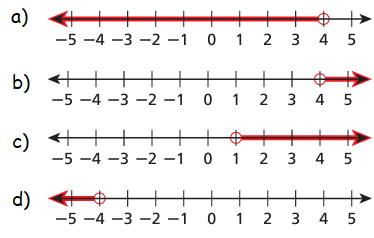
Solution :
-2(1 - x) < 3(x - 2)
Distributing -2 and 3 on both sides, we get
-2 + 2x < 3x - 6
Subtracting 3x on both sides
2x - 3x - 2 < -6
Adding 2 on both sides
-x - 2 < -6
-x < -6 + 2
-x < -4
Multiplying by -1 on both sides. While multiplying by negative, we have to flip the inequality sign.
x > 4
All values greater than 4 will be solution. So, option a is correct.
Example 7 :
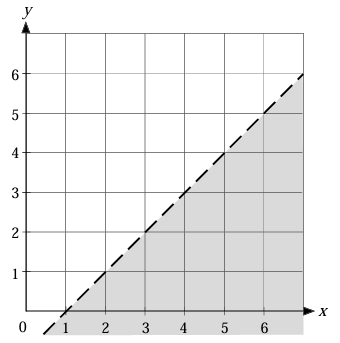
Considering the shaded region, it is below the line. Since it is dotted line, we may have to use < or >.
We don't see the y-intercept in the given figure. Choosing two points on the line, we get (2, 1) and (3, 2).
Slope = (y2 - y1) / (x2 - x1)
= (2 - 1) / (3 - 2)
= 1/1
= 1
Creating the equation :
y = mx + b
y = 1x + b
Applying the point (3, 2) in the equation above,
2 = 1(3) + b
2 = 3 + b
b = 2 - 3
b = -1
Applying the y-intercept, we get
y = x - 1
Choosing one of the points from the shaded region is (3, 1).
1 = 1(3) - 1
1 = 3 - 1
1 = 2
To make the statement true, we have to use the inequality sign <.
So, the required inequality representing the shaded region in the given figure is y < x - 1.
Kindly mail your feedback to v4formath@gmail.com
We always appreciate your feedback.
©All rights reserved. onlinemath4all.com
Recent Articles
-
Derivative of Absolute Value of x Using Limit Definition
Apr 23, 25 11:11 AM
Derivative of Absolute Value of x Using Limit Definition -
Digital SAT Math Problems and Solutions (Part - 149)
Apr 23, 25 02:33 AM
Digital SAT Math Problems and Solutions (Part - 149) -
Digital SAT Math Problems and Solutions (Part - 148)
Apr 22, 25 08:20 AM
Digital SAT Math Problems and Solutions (Part - 148)
